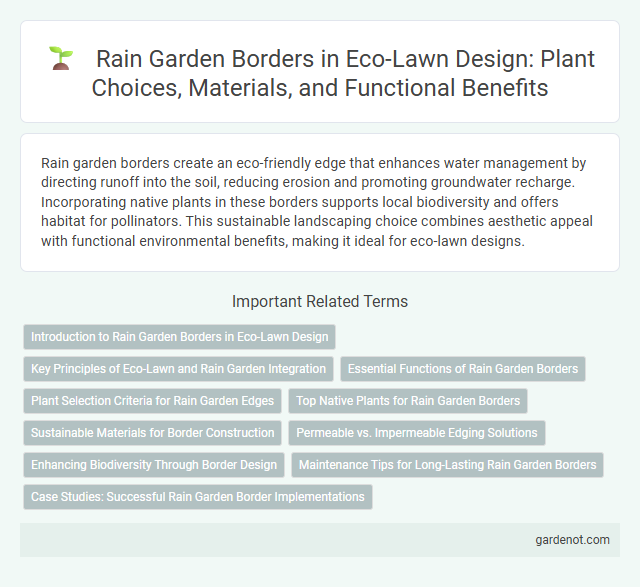Rain garden borders create an eco-friendly edge that enhances water management by directing runoff into the soil, reducing erosion and promoting groundwater recharge. Incorporating native plants in these borders supports local biodiversity and offers habitat for pollinators. This sustainable landscaping choice combines aesthetic appeal with functional environmental benefits, making it ideal for eco-lawn designs.
Introduction to Rain Garden Borders in Eco-Lawn Design
Rain garden borders in eco-lawn design serve as essential natural filtration zones that capture and absorb stormwater runoff, reducing soil erosion and improving water quality. Strategically planted with native vegetation, these borders enhance biodiversity by providing habitat for pollinators and wildlife while promoting soil health. Incorporating rain garden borders creates a sustainable landscape solution that harmonizes eco-lawn aesthetics with environmental resilience.
Key Principles of Eco-Lawn and Rain Garden Integration
Rain garden borders in eco-lawns enhance stormwater management by capturing and filtering runoff through native, deep-rooted plants that improve soil permeability and reduce erosion. Integrating key principles such as biodiversity, water conservation, and soil health ensures the eco-lawn supports local ecosystems while minimizing maintenance. These borders create natural habitats, improve groundwater recharge, and contribute to sustainable landscape resilience.
Essential Functions of Rain Garden Borders
Rain garden borders play a crucial role in managing stormwater by directing runoff into permeable soil, which enhances groundwater recharge and reduces erosion. These borders filter pollutants such as sediments, nutrients, and heavy metals, improving water quality while supporting native plant growth that stabilizes the soil. Properly designed rain garden borders also provide habitat for beneficial insects and contribute to urban biodiversity within eco-lawn systems.
Plant Selection Criteria for Rain Garden Edges
Selecting plants for rain garden borders requires prioritizing species with high tolerance to alternating wet and dry conditions, ensuring root structures that promote soil stabilization and erosion control. Native grasses, sedges, and perennials with deep, fibrous roots enhance water infiltration and provide habitat continuity along the garden edge. Emphasizing biodiversity with plants adapted to local climate supports ecological resilience and effective nutrient filtration at rain garden boundaries.
Top Native Plants for Rain Garden Borders
Top native plants for rain garden borders include bee balm (Monarda fistulosa), swamp milkweed (Asclepias incarnata), and blue flag iris (Iris versicolor), all valued for their deep roots that improve soil infiltration and prevent erosion. These species support local pollinators and enhance biodiversity while thriving in moist, well-drained conditions typical of rain gardens. Incorporating native sedges like Carex spp. further stabilizes the soil, creating an eco-friendly, low-maintenance border that optimizes stormwater management.
Sustainable Materials for Border Construction
Rain garden borders crafted with sustainable materials such as reclaimed wood, natural stone, and recycled plastic provide durable, eco-friendly solutions that enhance water filtration and prevent soil erosion. These materials reduce environmental impact by minimizing waste and promoting resource efficiency while supporting native biodiversity. Incorporating permeable, non-toxic substances ensures long-term resilience and effective rainwater management in eco-lawn design.
Permeable vs. Impermeable Edging Solutions
Rain garden borders benefit significantly from permeable edging solutions that allow water infiltration and support natural drainage, promoting healthy soil and plant growth. Impermeable edging, such as concrete or plastic barriers, can restrict water flow, causing runoff and potential erosion issues. Choosing permeable materials like gravel, porous stones, or untreated wood enhances rain garden functionality by maintaining moisture balance and reducing environmental impact.
Enhancing Biodiversity Through Border Design
Rain garden borders designed with native plants and diverse species create essential habitats for pollinators, birds, and beneficial insects, significantly enhancing local biodiversity. Incorporating layered vegetation and varying bloom times maximizes ecological benefits by providing continuous food sources and shelter throughout the seasons. Strategic border design also improves water filtration and soil health, supporting a resilient and sustainable eco-lawn ecosystem.
Maintenance Tips for Long-Lasting Rain Garden Borders
Rain garden borders require regular weeding and mulching to maintain soil health and prevent erosion, ensuring long-lasting structure and plant vitality. Periodic inspection for plant overgrowth or damage allows timely trimming and replacement, supporting water filtration and habitat function. Proper watering schedules during dry periods promote root establishment, enhancing the rain garden's ability to manage stormwater effectively.
Case Studies: Successful Rain Garden Border Implementations
Rain garden borders have been successfully implemented in urban residential areas, effectively reducing stormwater runoff by up to 40% through strategic planting of native vegetation such as switchgrass and blue flag iris. Case studies in Portland and Minneapolis demonstrate improved groundwater recharge and enhanced biodiversity, with maintenance costs reduced by 30% compared to traditional lawn edges. These eco-lawn applications support sustainable urban landscaping by combining water management and habitat restoration practices.
Rain garden border Infographic

 gardenot.com
gardenot.com